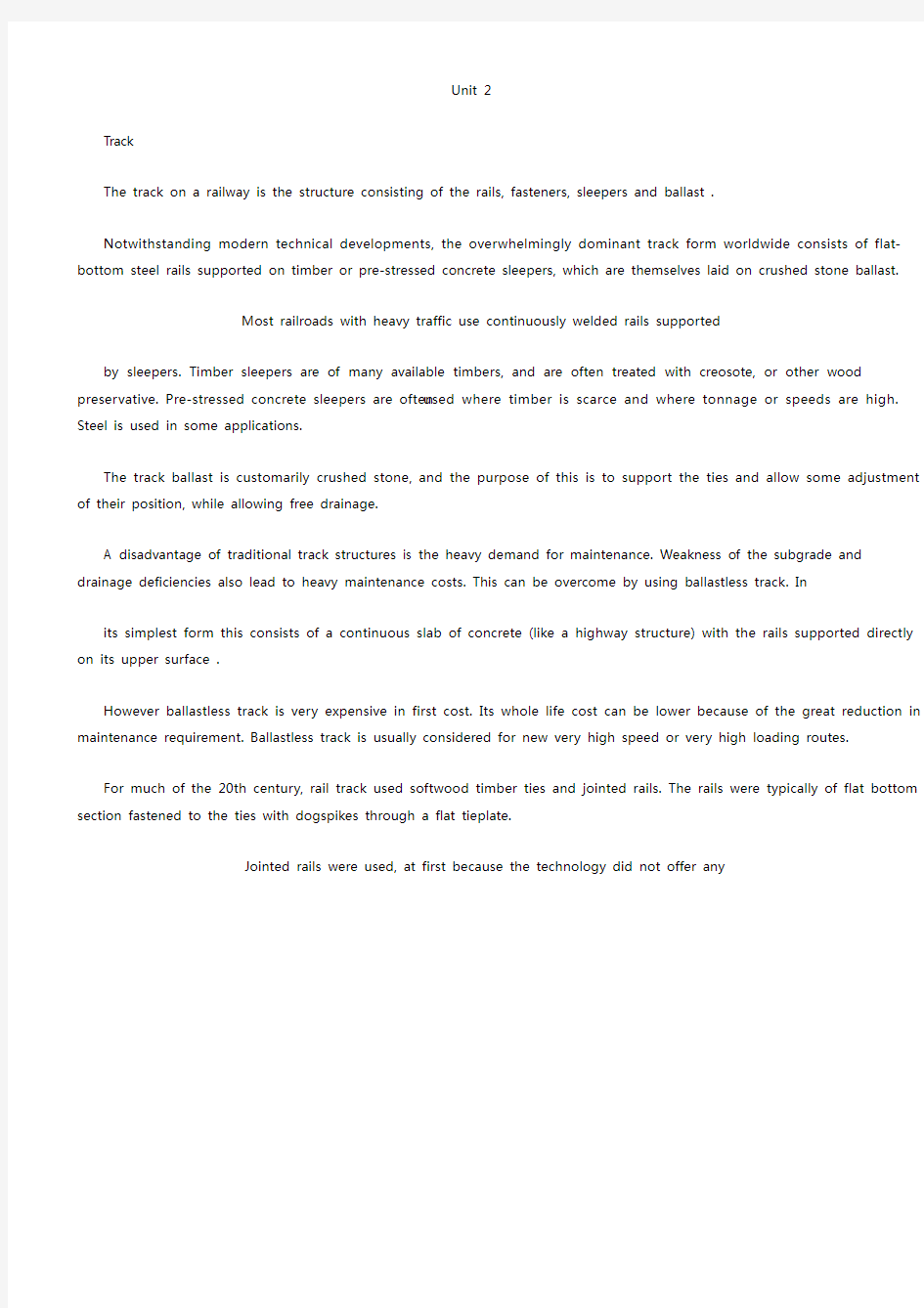
高职高专实用英语Unit2课文+译文
- 格式:docx
- 大小:9.29 KB
- 文档页数:2


Unit 2
Track
The track on a railway is the structure consisting of the rails, fasteners,
sleepers and ballast .
Notwithstanding modern technical developments, the overwhelmingly dominant track form worldwide consists of flat-bottom steel rails supported on timber or pre-stressed concrete sleepers, which are themselves laid on crushed stone ballast.
Most railroads with heavy traffic use continuously welded rails supported
by sleepers. Timber sleepers are of many available timbers, and are often treated with creosote, or other wood preservative. Pre-stressed concrete sleepers are often used where timber is scarce and where tonnage or speeds are high. Steel is used in some applications.
The track ballast is customarily crushed stone, and the purpose of this
is to support the ties and allow some adjustment of their position, while
allowing free drainage.
A disadvantage of traditional track structures is the heavy demand for maintenance. Weakness of the subgrade and drainage deficiencies also lead to heavy maintenance costs. This can be overcome by using ballastless track. In
its simplest form this consists of a continuous slab of concrete (like a
highway structure) with the rails supported directly on its upper surface .
However ballastless track is very expensive in first cost. Its whole life cost can be lower because of the great reduction in maintenance requirement. Ballastless track is usually considered for new very high speed or very high loading routes.
For much of the 20th century, rail track used softwood timber ties and jointed rails. The rails were typically of flat bottom section fastened to the
ties with dogspikes through a flat tieplate.
Jointed rails were used, at first because the technology did not offer any
alternative. However the intrinsic weakness in resisting vertical loading results in
the ballast support becoming depressed and a heavy maintenance workload is imposed to prevent unacceptable geometrical defects at the joints. The joints also required to be lubricated, and wear at the fishplate (joint bar) mating surfaces needed to be rectified by shimming. For this reason jointed track is not financially appropriate for heavily operated railroads.
译文
轨道
铁路轨道是由铁轨、紧固件、枕木和道渣组成的结构。
尽管有了现代技术的发展,但是全世界的铁路轨道绝大多数是由底部平坦的
钢轨组成的。这些钢轨由木质或预应力混凝土枕木支撑,枕木本身摆放在碎石道
渣上。
多数运输繁忙的铁路使用连续焊接钢轨,这些钢轨由枕木支撑。木质枕木要
使用很多木材,这些木材经常用木馏油或者其他木材防腐剂处理。预应力混凝土
枕木经常用于木材稀少的地方,以及运输吨数大、速度高的情况。有时也使用钢
制枕木。
铁路轨道的道渣通常使用碎石,道渣的用途是支撑枕木,可以允许枕木的位
置有所调整,可以使路基自由排水。
传统铁路轨道结构的缺点是需要大量的维护。路基和排水不足的缺点也导致
高昂的维护费用。这种情况可以通过使用无道砟轨道来克服。最简单的无道砟轨
道形式是连续不断的混凝土厚板(类似一种公路结构),铁轨直接摆放在混凝土厚
板的表面上。
然而,无砟轨道的首次投资是很昂贵的。但是它的总体费用是低的,因为所
需要的维护大大降低了。在新建的高速铁路和重载铁路上通常会考虑使用无砟轨道。
在20 世纪的大部分时间里,铁路轨道使用软木材制作的枕木和有缝钢轨。
标准的钢轨底部平坦,用道钉通过枕木垫板固定在枕木上。
最初使用有缝钢轨是因为当时的技术使人们没有其他选择。然而要抵抗纵向荷
载的自身缺陷导致道砟基础的下沉,要采取大量的维护工作以防止接缝处出现不能
容忍的磨损。钢轨的接缝处也需要润滑,接缝处与鱼尾板的啮合面也会磨损,需要
加垫片修正。由于这一原因,有缝轨道最终并不适应重载铁路。